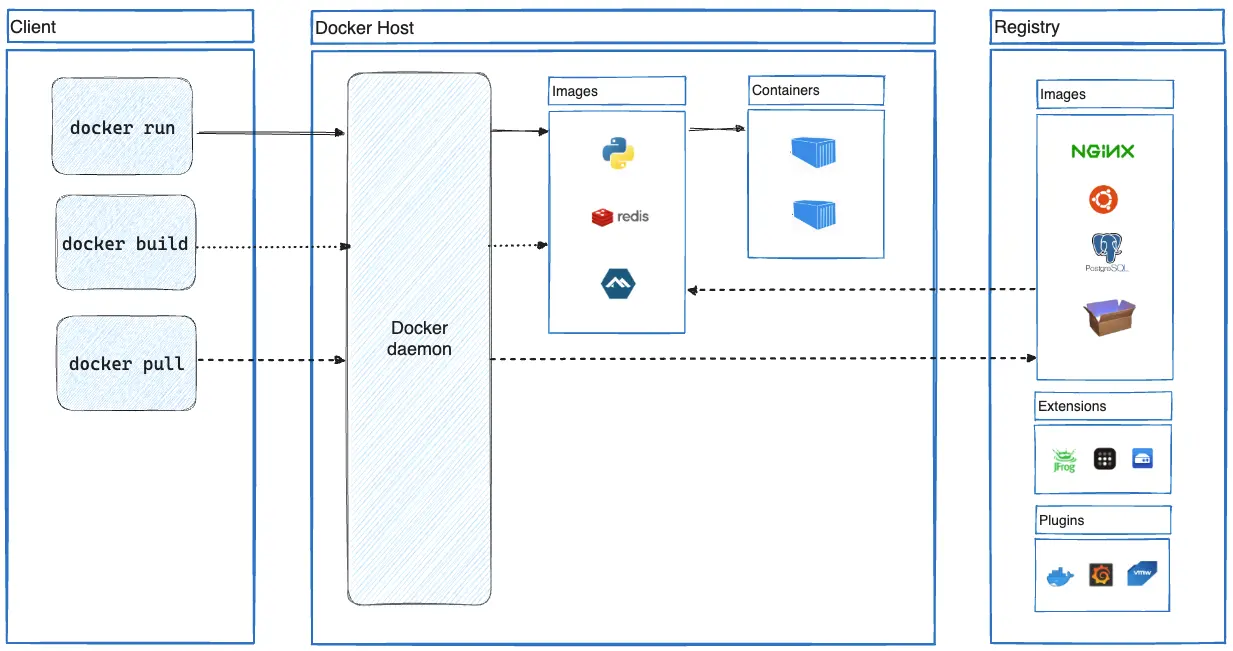5.9 KiB
5.9 KiB
theme, background, title, info, class, drawings, transition, mdc
| theme | background | title | info | class | drawings | transition | mdc | ||
|---|---|---|---|---|---|---|---|---|---|
| seriph | https://cover.sli.dev | Welcome to Slidev | ## Slidev Starter Template Presentation slides for developers. Learn more at [Sli.dev](https://sli.dev) | text-center |
|
slide-left | true |
Demystifying Docker
Mike Conrad - SCS 2025
Press Space for next page
transition: fade-out layout: center
Why Containers?
- "It works on my machine" is a thing of the past
- Containers are lightweight and portable
- Boot in milliseconds
- Ideal for reproducible dev environments
transition: fade-out layout: center
Containers vs Virtual Machines
| Feature | VM | Container |
|---|---|---|
| Boot time | Minutes | Seconds |
| Resource usage | Heavy | Lightweight |
| Isolation | Strong | Process-level |
| Portability | Medium | Very High |
In reality we often use containers and vm's together. Containers run inside of VM's for better security and isolation, especially in cloud and multi tenant environments.
transition: fade-out layout: center
What is Docker?
- A tool to build and run containers
- Docker engine runs containers using OS features:
- Namespaces
- cgroups
- Union file systems
- Uses images layered from base -> app code
transition: fade-out layout: center
transition: fade-out layout: center
Docker Architecture
Docker Engine (Server) <-- REST API --> Docker CLI (Client)

transition: fade-out layout: center
Docker Under the Hood
- Namespaces: isolate PID, net, mount, etc.
- cgroups: control CPU, memory, IO
- UnionFS: layered filesystem (AUFS, OverlayFS)
transition: fade-out layout: center
Anatomy of a Dockerfile
FROM node:22-slim
WORKDIR /app
COPY package*.json ./
RUN npm install
COPY . .
EXPOSE 3000
CMD ["npm", "start"]
- Starts with a base image
- Copy files and install deps
- Set default command
transition: fade-out layout: center
Dockerfile Best Practices
# Stage 1: Build the Go binary
FROM golang:1.24.2-alpine AS builder
# Set working directory inside the build container
WORKDIR /app
COPY go.mod ./
RUN go mod download
COPY . .
# Build the Go binary statically
RUN CGO_ENABLED=0 GOOS=linux go build -o docker-api-proxy .
# Stage 2: Run binary in minimal container
FROM scratch
# Copy binary from builder
COPY --from=builder /app/docker-api-proxy /usr/local/bin/docker-api-proxy
# Run binary
ENTRYPOINT ["docker-api-proxy"]
EXPOSE 80
- Use specific versions, not
latest - Combine commands to reduce layers
- Use
.dockerignore - Prefer slim or alpine images
- Run as non-root user if possible
transition: fade-out layout: center
What is Docker Compose?
- Define multi-container apps in one file
- Great for local dev and staging (and production!)
name: traefik_secure
services:
socket-proxy:
image: git.hackanooga.com/mikeconrad/docketproxy:latest
container_name: socket-proxy
networks:
- traefik
- socket_proxy
volumes:
- /var/run/docker.sock:/var/run/docker.sock:ro
read_only: true
security_opt:
- no-new-privileges:true
cap_drop:
- ALL
restart: unless-stopped
environment:
- ALLOWED_NETWORKS=traefik_secure_traefik
traefik:
image: traefik:latest
container_name: traefik
command:
- "--log.level=INFO"
- "--entrypoints.web.address=:80"
- "--entrypoints.websecure.address=:443"
- "--providers.docker=true"
- "--providers.docker.endpoint=tcp://socket-proxy:8000"
- "--providers.docker.exposedbydefault=false"
- "--entrypoints.traefik.address=:8080"
- "--api.insecure=true"
- "--api.dashboard=true"
labels:
- "traefik.enable=true"
- "traefik.http.routers.api.rule=Host(`traefik.docker.localhost`)"
- "traefik.http.routers.api.entrypoints=web"
- "traefik.http.routers.api.service=api@internal"
ports:
- "80:80"
- "8080:8080"
networks:
- traefik
- socket_proxy
depends_on:
- socket-proxy
restart: unless-stopped
whoami:
image: traefik/whoami
networks:
- traefik
labels:
- "traefik.enable=true"
- "traefik.http.routers.whoami.rule=Host(`whoami.docker.localhost`)"
- "traefik.http.routers.whoami.entrypoints=web"
networks:
traefik: {}
socket_proxy:
driver: bridge
internal: true
enable_ipv6: false
